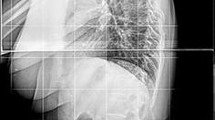Abstract
Study Design
Retrospective comparative case series.
Objectives
Evaluation of sacral morphology in spondylolisthesis patients compared with asymptomatic controls.
Summary of Background Data
Patients with spondylolisthesis are known to differ from asymptomatic controls in sagittal plane anatomy, but few studies examine the coronal and axial plane differences in these cohorts.
Methods
This is a retrospective evaluation of magnetic resonance imaging of the lumbosacral spine in 29 spondylolisthesis patients and an asymptomatic cohort (n = 154). Measurements of the linear distance and angular position of L5 and sacrum were performed in the sagittal, coronal, and axial planes. Receiver operating characteristic (ROC) curve analysis quantified these associations. High- and low-grade spondylolisthesis patients were compared with two-sample t-tests. All p-values are two-sided and considered significant when p < .05.
Results
Axial measurements showed the distance of the right to left anterior ala and the L5 body width did not differ between the cohorts. Sacroiliac (SI) joint angles in the spondylolisthesis cohort were closer to the true sagittal plane than in the controls 109° versus 121° (p < .001). In the sagittal plane, the linear measurement of the ratio of the midpoint anteroposterior width L5 to the sacral end plate was larger in the high-grade patients than the low-grade patients and controls. In addition, the kyphosis between S1–S2 and S2–S3 was larger in the spondylolisthesis cohort.
Conclusions
The SI joints in patients with spondylolisthesis were orientated closer to the sagittal plane than in the controls. An awareness of this positioning may be important in surgical implant insertion as well as rehabilitation of hip extensor weakness. The main anatomical differences found in this study were in the sagittal plane. Sacral end plate abnormalities were well visualized and consistent with radiographic findings in the literature.
Level of Evidence
Level III, diagnostic.
Similar content being viewed by others
References
Diebo BG, Lafage V, Schwab F. Pelvic incidence: the great biomechanical effort. Spine 2016;41:S21–2.
Hresko MT, Labelle H, Roussouly P, et al. Classification of high-grade spondylolistheses based on pelvic version and spine balance: possible rationale for reduction. Spine 2007;32:2208–13.
Labelle H, Roussouly P, Berthonnaud E, et al. Spondylolisthesis, pelvic incidence, and spinopelvic balance: a correlation study. Spine 2004;29:2049–54.
Legaye J, Duval-Beaupère G, Hecquet J, et al. Pelvic incidence: a fundamental pelvic parameter for three-dimensional regulation of spinal sagittal curves. Eur Spine J 1998;7:99.
Vaz G, Roussouly P, Berthonnaud E, et al. Sagittal morphology and equilibrium of pelvis and spine. Eur Spine J 2002;11:80.
Vialle R, Levassor N, Rillardon L, et al. Radiographic analysis of the sagittal alignment and balance of the spine in asymptomatic subjects. J Bone Joint Surg 2005;87:260–7.
Broome DR, Hayman LA, Herrick RC, et al. Postnatal maturation of the sacrum and coccyx: MR imaging, helical CT, and conventional radiography. Am J Roentgenol 1998;170:1061–6.
Marty C, Boisaubert B, Descamps H, et al. The sagittal anatomy of the sacrum among young adults, infants, and spondylolisthesis patients. Eur Spine J 2002;11:119.
Wiltse LL, Newman PH, McNab I. Classification of spondylolisis and spondylolisthesis. Clin Orthop Relat Res 1976;117:23–9.
Marchetti PG, Bartolozzi P. Classification of spondylolisthesis as a guide to treatment. In: Bridwell KH, DeWald RL, editors. Textbook of Spinal Surgery. 2nd ed. Philadelphia, PA: Lippincott-Raven; 1997. p. 1211–54.
Montgomery RA, Hresko MT, Kalish LA, et al. Spondylolisthesis: intra-rater and inter-rater reliabilities of radiographic sagittal spinopelvic parameters using standard picture archiving and communication system measurement tools. Spine Deform 2013;1:412–8.
Whitesides TE, Horton WC, Hutton WC, et al. Spondylolytic spondylolisthesis: a study of pelvic and lumbosacral parameters of possible etiologic effect in two genetically and geographically distinct groups with high occurrence. Spine 2005;30(6 suppl):S12–21.
Mac-Thiong J-M, Labelle H, Parent S, et al. Assessment of sacral doming in lumbosacral spondylolisthesis. Spine 2007;32:1888–95.
Hanley JA, McNeil BJ. The meaning and use of the area under a receiver operating characteristic (ROC) curve. Radiology 1982;143:29–36.
Janes H, Pepe MS. Adjusting for covariates in studies of diagnostic, screening, or prognostic markers: an old concept in a new setting. Am J Epidemiol 2008;168:89–97.
Yue WM, Brodner W, Gaines RW. Abnormal spinal anatomy in 27 cases of surgically corrected spondyloptosis: proximal sacral end-plate damage as a possible cause of spondyloptosis. Spine 2005;30(6 suppl):S22–6.
Author information
Authors and Affiliations
Corresponding author
Additional information
Author disclosures: MTH (none), DGD (none), EH (none), LAK (none).
IRB approval: Boston Children’s Hospital.
Funding: No external funding was used.
Rights and permissions
About this article
Cite this article
Hresko, M., Deckey, D.G., Hinchcliff, E. et al. Comparative Sacral Morphology in Spondylolisthesis Patients. Spine Deform 7, 945–949 (2019). https://doi.org/10.1016/j.jspd.2019.03.008
Received:
Revised:
Accepted:
Published:
Issue Date:
DOI: https://doi.org/10.1016/j.jspd.2019.03.008




